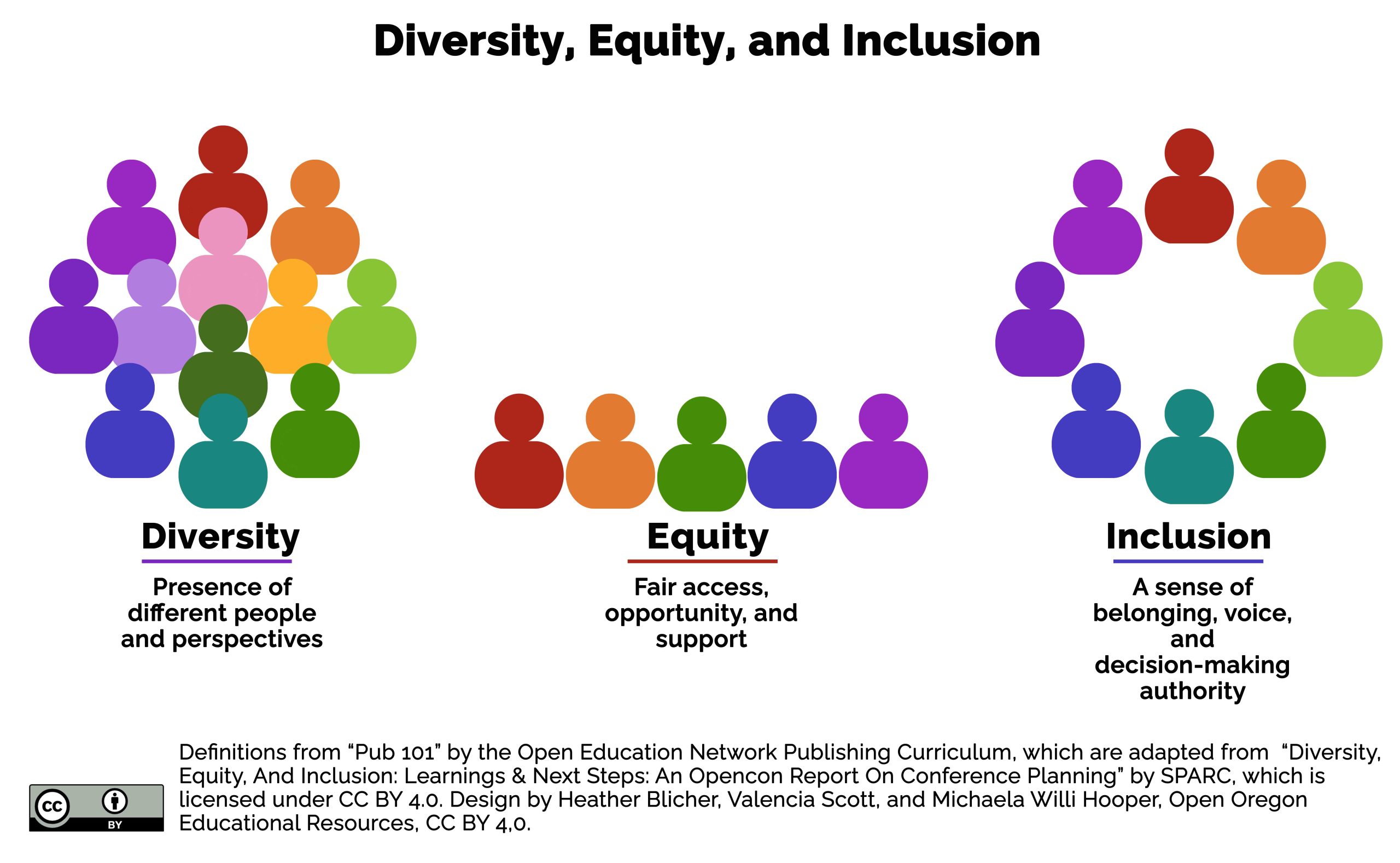1.2 Diversity, Equity, and Inclusion
Heather Blicher and Valencia Scott
What is DEI?
This acronym and other versions of it are often used, but not always defined.
Diversity is the variety of characteristics that make up individuals’ unique identities, including race, gender, age, ethnicity, sexual orientation, body size, abilities, and many others.
Equity is the fair treatment, access, opportunity, and advancement for all individuals, while at the same time striving to identify and eliminate barriers that have prevented the full participation of marginalized groups of people.
Inclusion refers to creating a culture where everyone feels a sense of belonging and is valued for their unique perspectives and contributions.

Together, diversity, equity, and inclusion are a set of principles that can guide us in understanding how to value and leverage the differences between people to foster anti-oppressive learning environments.
What is the difference between equality and equity?
Equality and equity are similar in that they both aim to promote fairness and justice for all individuals, but they approach this goal in different ways.
Equality is about treating everyone the same, regardless of their individual differences or needs. This approach assumes that everyone starts from the same place and has the same opportunities, so if everyone is given the same resources and support, it is assumed they will all achieve the same outcomes.
Equity recognizes that individuals have different needs and starts from the understanding that not everyone has the same advantages or opportunities. It aims to level the playing field by providing resources and support in a way that addresses these individual differences and needs.
Figure 1.2. On this episode of The Harbor by Jostens, guest Cammy Watkins explains the differences between equity and equality, and how equity goes further by recognizing that everyone starts with unique advantages and disadvantages, and therefore needs different solutions in order to establish fair access and opportunity.
Why are we focused on equity?
Diversity cannot be separated from equity, and equity is vital to sustainable inclusion: Equity is the bridge between institutional representation and institutional action.
Some of the main goals of DEI frameworks include:
- Representation of intersectional identities (e.g. race/ethnicity, gender/gender expression, sexuality, religion, ability, and socioeconomic background – among many others)
- Acknowledgment of social inequalities and power dynamics which have led to historically exclusive practices and structural inequities within higher education
- Introspective analysis of an organization’s complicity in/perpetuation of social disparities and reframing institutional culture, structures, and thinking to rectify inequities specific to the organization
An example of the difference between equality and equity is in education: equality in education would mean that every student is given the textbook, while equity in education would mean that each student is given the textbook and any resources they need to succeed, such as providing accommodations for students with disabilities.
In short, equality is treating everyone the same, equity is treating everyone fairly.
Self Check
References
Jostens. (2021). Ep.6.23 Equity vs. Equality [YouTube Video].
Additional Reading
MPH@GW, the George Washington University Online Master of Public Health program. (2022). Equity vs. equality: what’s the difference?
Pike, U. (2019). Taking OER off-campus: equity is about more than saving money. CCCOER Blog: Equity and Openness: Perspectives from North American Colleges and Universities.
U.S. Department of Education (n.d.). Department of education equity action plan.
West, Q. (2019). Overview of EDI and open education. CCCOER Blog: Equity and Openness: Perspectives from North American Colleges and Universities.
Image Descriptions
Figure 1.1 Image description: A grouping of shapes meant to represent people (each with a small circle on top of a wider circle for a head and body) in many colors represents diversity. Diversity is defined under this as the presence of different people and perspectives. A horizontal line of people shapes in many colors represent equity. Equity is defined under this as fair access, opportunity, and support. A circular grouping of people shapes in many colors represents inclusion. Inclusion is defined under this as a sense of belonging, voice, and decision-making authority. The attribution statement reads, definitions from Pub 101 by the Open Education Network Publishing Curriculum, which are adapted from “Diversity, Equity, and Inclusion: Learning and Next Steps, an OpenCon Report on Conference Planning, by SPARC, which is licensed under CC BY 4.0. Design by Heather Blicher, Valencia Scott, and Michaela Willi Hooper, Open Oregon Educational Resources, CC BY 4.0. [Return to Figure 1.1]
Licenses and Attributions
Open Content, original
“Diversity, Equity, and Inclusion” by Heather Blicher and Valencia Scott for Open Oregon Educational Resources [Website] is licensed CC BY 4.0.
The variety of characteristics that make up individuals’ unique identities, including race, gender, age, ethnicity, sexual orientation, body size, abilities, and many others.
Equity recognizes that individuals have different needs and starts from the understanding that not everyone has the same advantages or opportunities. It aims to level the playing field by providing resources and support in a way that addresses these individual differences and needs.
Creating a culture where everyone feels a sense of belonging and is valued for their unique perspectives and contributions.
Intersectionality is a lens through which you can see where power comes and collides, where it interlocks and intersects (Crenshaw 2017). This concept recognizes that individuals:
1) belong to more than one social category simultaneously and
2) may experience either privileges or disadvantages on that basis depending on circumstances and relationships (University of Washington).

